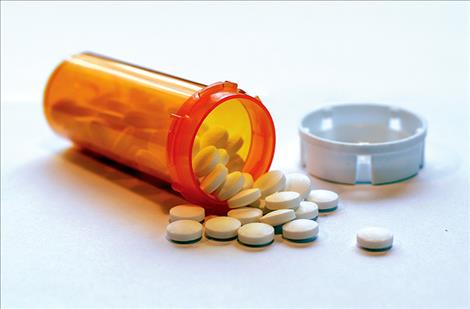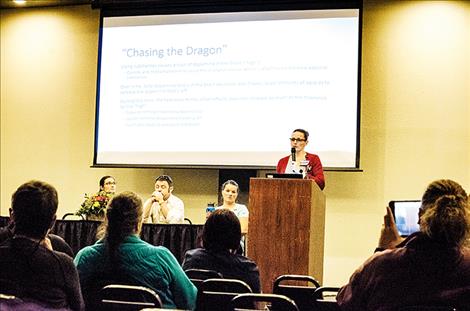Polson medical center tackles opioid problem
Hey savvy news reader! Thanks for choosing local.
You are now reading
1 of 3 free articles.
POLSON – Opioid overdoses are the third leading cause of injury-related deaths in Montana, according to a Montana Department of Health and Human Services report. Statistics like this have brought healthcare providers and state leaders together to tackle the problem with measured results.
Governor Steve Bullock released a report detailing improvements in several key areas of prescription opioid use in Montana, including a decrease in the number and strength of opioids prescribed to patients.
“This newly-released report, called ‘Opioid Prescribing Practices in Montana, 2012-2017’ is the result of a DPHHS partnership with the Montana Board of Pharmacy in 2018 to analyze data from the Montana Prescription Drug Registry. The key findings from the report indicate that between 2012 and 2017 there was a four percent overall decrease in the opioid prescription rates in Montana. The average daily dose of prescription opiates decreased by nearly 23 percent during this time. Additionally, the proportion of Montana residents prescribed high (90 morphine milliequivalents) and very high (180 MME) doses decreased by 35 percent and 40 percent, respectively.”
The governor’s press release said that the report shows Montana healthcare providers and health systems are working to find a balance between the appropriate prescribing of these medications and ensuring their patients are receiving the care they need.
DPHHS State Medical Officer Dr. Greg Holzman is optimistic about the report results. He said it is important to view this data within the context of the overall goal of caring for patients with pain, decreasing the risk of misuse and addiction and preventing overdose deaths.
“We need to make sure individuals who are addicted have access to treatment, individuals who are on high dose opioid are weaned slowly with compassion and care, and for those individuals on opioids where the benefit of the medication outweighs the risk, we want to make sure they use the medication in the safest way for themselves and their community,” Holzman said.
In 2017, Bullock signed a standing order for Naloxone to be available in the state. Any Montanan can get the opioid reversal medication from a local participating pharmacy without a prescription. “Since 2018, DPHHS has distributed 2,100 units of Naloxone, with a majority of the units going to law enforcement and first responders, and 419 individuals have been trained as master trainers on how to administer the life-saving drug,” the press release states.
In Montana, the opioid problem peaked in 2009 causing officials in the state to take action to develop resources. Research has shown that a combination of medication and therapy can successfully treat some people struggling with addiction. One of the eight treatment centers in the state is located in Polson.
On Thursday, Oct. 3, caregivers with the Polson program held an open event to talk about the opioid crises and treatment options in the community. Providence Saint Joseph Medical Center is running the Integrated Medication Assisted Treatment program that consists of healthcare providers, counselors and peer support.
Maria McNeil Williams, a nurse with St. Joseph, welcomed law enforcement, teachers, medical professionals and concerned citizens to the event. She said addiction is a very “polarizing” topic. She asked people to keep an open mind as the evening progressed. “Everyone knows our community is struggling,” she said of opioid addiction.
Before treatment was talked about and questions were asked, opioids were defined as painkillers. Opioids can include prescription painkillers like oxycodone and street drugs like heroin. She said people use the term “chasing the dragon” to describe the rush they get from opioids and methamphetamines. “People continue to chase that feeling,” she said, adding that it is extremely addictive.
Williams said the opioid problem started in the United States in the 90s when a group of physicians decided to use pain as a vital sign. “They were funded by pharmaceutical companies,” she said. In 2015, the United States consumed 99.7 percent of the world’s hydrocodone, but a year later, the numbers started to drop after the Centers for Disease Control released pain management guidelines.
She said people were urged to try taking Tylenol for their pain instead of opioids. With changes in opioid prescription practices, it became evident that people needed opioid addiction treatment programs.
In 2017, Montana launched the use of Medication-Assisted Treatment, which involves the use of medication, behavioral health, peer support and team coordinated care to treat substance use disorders and prevent opioid overdose. The Governor’s report states, “Research shows that a combination of medication and therapy can successfully treat these disorders, and for some people struggling with addiction, MAT can help sustain recovery. MAT increases treatment retention, reduces relapse, improves social functioning, reduces transmission of infectious diseases such as hepatitis C and HIV, reduces criminal activity and reduces overdose deaths.”
The Montana Primary Care Association provided training throughout the state, and at this time, Montana now has over 130 MAT providers. “When this effort began in 2017, Montana had just over 20 providers,” according to a report. “As of August 2019, a total of 757 patients were offered MAT, behavioral health counseling and recovering support services. Most patients were between ages 25 to 44. Williams added that extreme caution is utilized to protect patient identity to help them succeed.
She has seen patients from all backgrounds and ages. One of the youngest patients was eight years old and received pills from a parent “for doing chores.” She said 12-14-year-olds sometimes start with alcohol and then move on to opioid pills they get from a friend who might have taken them from a parent or someone else with a prescription. She recommends that people dispose of any extra pills in a certified drop-off box.
According to the Governor’s report, “There is more prescription drop off locations today in Montana than ever before with over 165 boxes in 55 counties. This increase in the number of locations is a direct result of a grant announced in August 2018 to distribute collection boxes to local pharmacies. Dropbox locations can be found at this link https://dphhs.mt.gov/amdd/substanceabuse/dropboxlocations.
Along with counseling, MAT addiction programs can involve the use of Buprenorphine, which is a partial opioid for pain control. Practitioners are required to obtain a waiver to prescribe and dispense medications like buprenorphine. “It’s rarely abused,” she said.
Buprenorphine and methadone are sometimes used to help pregnant women with addiction. Williams said research has found that medication-based treatment can help create a more stable environment for baby and mom, rather than the highs and lows caused by drug abuse.
She said earlier in the discussion that in 2015-2016 approximately one-third of all babies born in Lake County were drug affected, making treatment a necessity. She didn’t have exact numbers for this year but said the statistics were improving – although, she said, more still needs to be done.
She talked about what success might look like for anyone struggling with addiction. “In a perfect world, a person would be off everything, but it’s not possible for some.” The idea is not to count the number of days a person hasn’t used, which can cause anxiety and relapse, but to utilize medication and therapy to individualize a treatment program, and they don’t “kick people out” for relapsing. “
“A person going from using five times a day to twice in six months is an improvement, not a failure,” she said. The program is goal-focused with measured successes that include employment, getting a car, healing broken relationships and improving health.
Many false ideas about what addicts should and shouldn’t do create barriers to success, she said, including the idea that a person should “just be able to quit” using drugs and never use again. “You can’t expect people to go from 60 to zero,” she said. And abstinence programs often cause addicts to trade one addiction for another. She said people need counseling, medication and individualized treatment.
Williams said an unlikely barrier to recovery comes from the healthcare system. She said some healthcare providers need to learn that they can’t “treat people with addiction like crap.” She said people need to be treated with compassion and that addiction is a complex problem.
St. Joseph representative Lisa Grainey talked at the event and explained the admission process for opioid-addiction treatment. People can call the medical center and ask for help or be admitted by referral. She said healthcare providers determine a patient’s needs and level of care. The patient works with a therapist to create a treatment plan with goals. Family support is encouraged. She said the goal of the program is to live a self-directed life.
As a peer support specialist, Marcus Sands spoke at the event. He said his experience with addiction allowed him to help others. He lost his sight to diabetes as a child. After taking pills for medical problems, he moved onto drugs like cocaine and oxycodone. He overdosed at the age of 30 and ended up in the emergency room. He said he had “every excuse” to keep using drugs but decided to try not using. He started lifting weights and became the number one champion bowler in the nation for blind people. Today, he said there are a lot of “triggers” that make him want to use again. “The thing is … things can get better,” he said. “Everyday, I try to inspire people and let them know that there is hope.”

















